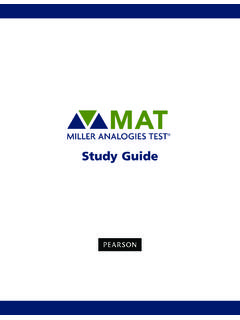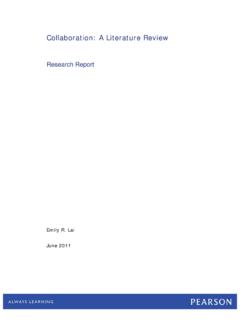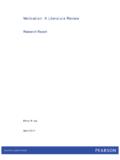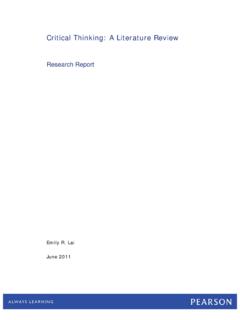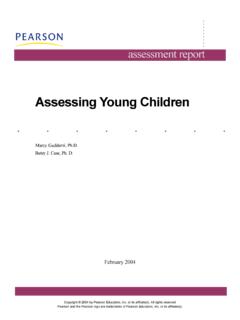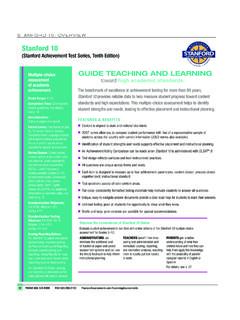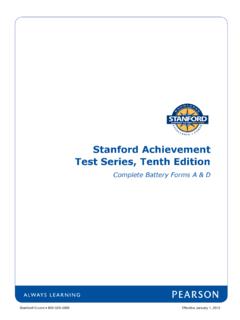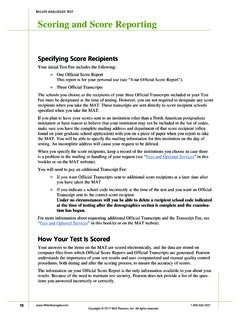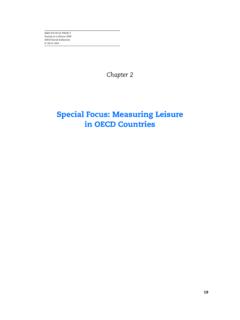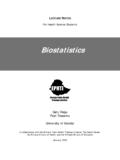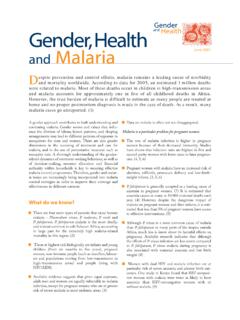Transcription of Adaptive Behavior Assessment System (ABAS) - Technical ...
1 Adaptive Behavior Assessment System Technical Supplement New Adaptive Domain Composite Scores The Adaptive Behavior Assessment System (ABAS; Harrison & Oakland, 2000) uses a Behavior -rating format to assess Adaptive Behavior and related skills for individuals 5 through 89 years of age. Information on children can be provided by parents and/or teachers; information on adults can be provided by significant others, care providers, supervisors, and/or the client independently. ABAS scores help describe a person s general Adaptive Behavior as well as his or her functioning in ten related Adaptive skill areas: communication, community use, functional academics, school/home living, health and safety, leisure , self-care, self-direction, social, and work (for older adolescents and adults). These skill areas encompass the practical, everyday skills required to function and meet environmental demands, including those needed to effectively and independently care for oneself and to interact with others.
2 The ABAS was developed using three types of information: (1) a concept of Adaptive skills promoted by the American Association on Mental Retardation (AAMR) (AAMR, 1992; AAMR, 2002; Grossman, 1983; Heber, 1959); (2) legal and professional standards applicable to various special education and disability classifications ( , Individuals with Disabilities Education Act, 1997; the American Psychiatric Association s Diagnostic and Statistical Manual of Mental Disorders Fourth Edition (DSM IV), 1994; 2000); and (3) research investigating diagnoses and interventions for persons with various disabilities. Professionals can use the ABAS to assess the level of functioning of persons who may have a variety of disabilities ( , Alzheimer s disease, Attention-Deficit/ Hyperactivity Disorders, Autistic Disorder and other Pervasive Developmental Disorders, behavioral and emotional disorders, neuropsychological disorders, learning disabilities, and sensory and physical impairments).
3 The ABAS is used frequently in the Assessment of persons with mental retardation. In 1992, AAMR defined mental retardation as ..characterized by significant subaverage intellectual functioning, existing concurrently with related limitations in two or more of the following applicable Adaptive skill areas: communication, self-care, home living, social skills, community use, self-direction, health and safety, functional academics, leisure , and work. Mental retardation manifests before age 18 (p. 5).Copyright 2008 by Pearson Education, Inc. or its affiliate(s). All rights reserved. 2 The definition of mental retardation in the DSM IV does not significantly differ from the AAMR s 1992 definition. Both the AAMR and the DSM IV stress that in addition to acquiring information on a person s general Adaptive Behavior , it is important to assess the ten Adaptive skill areas when diagnosing mental retardation.
4 Knowledge of these Adaptive skill areas is also thought to have considerable value for the therapist during evaluation and in program planning. The AAMR (2002) recently revised its definition of mental retardation to state: Mental retardation is a disability characterized by significant limitations both in intellectual functioning and in Adaptive Behavior as expressed in conceptual, social, and practical Adaptive skills. This disability originates before age 18 (p. 8). Under these new guidelines, a significant limitation in Adaptive Behavior is operationally defined as performance that is at least two standard deviations below the mean of any one of the three broad Adaptive skill areas, or of an overall score on a standardized measure. Thus, the AAMR reaffirms the importance of examining the ten Adaptive skill areas measured by the ABAS, and groups them into three broad domains: conceptual, social, and practical.
5 The conceptual domain includes the skill areas of communication, functional academics, self-direction, and health and safety. The social domain includes the social and leisure skill areas. The practical domain includes the skill areas of self-care, home living, community use, health and safety, and work. Although the AAMR places the health and safety skill area in both the conceptual and practical domains, the authors of ABAS have placed it only in the practical domain. This placement is based on item content and simplifies the creation of the new domain composites. In light of the AAMR s 2002 definition, professionals who use the ABAS to assess mental retardation are likely to rely on three levels of scores: the General Adaptive Composite; the three newly established composite scores for the conceptual, social, and practical Adaptive domains; and the scaled scores for the ten skill areas.
6 The scores provide three different perspectives of Behavior important to diagnosis and intervention. The General Adaptive Composite and scaled scores for the ten Adaptive skill areas are reported in the ABAS Manual (Harrison & Oakland, 2000). To be consistent with the new AAMR definition, this Technical Supplement provides composite scores for the three Adaptive domains. These composites are based on data reported in the ABAS Manual. Tables 1 and 2 of this Technical Supplement show evidence of internal consistency reliability and the standard errors of measurement for the three new composites, respectively. The normative data for the three composites are provided in Appendix A for each Rating Form (Teacher, Parent, Adult-Self Report, and Adult-Rated by Others). Copyright 2008 by Pearson Education, Inc.
7 Or its affiliate(s). All rights reserved. 3 Table 1 ABAS Reliability Coefficients for the New Composites Teacher Form Age Group Composite 5 6 7 8 9 10 11 12 13 14 15 16 17 21 Average rxx Conceptual .96 .97 .97 .98 .98 .98 .99 .98 .98 .99 .98 .98 Social .96 .97 .96 .97 .97 .97 .98 .97 .97 .98 .97 .97 Practical .95 .97 .96 .98 .97 .97 .98 .98 .98 .98 .97 .97 Parent Form Age Group Composite 5 6 7 8 9 10 11 12 13 14 15 16 17 21 Average rxx Conceptual .96 .97 .96 .97 ..96.
8 97 .97 .97 .98 .97 Social .94 .95 .94 .95 ..95 .96 .96 .96 .96 .95 Practical .96 .96 .95 .97 ..95 .97 .96 .96 .98 .96 Adult Form, Self Report Age Group Composite 16 21 22 2930 3940 4950 6465 7475 89 Average rxx Conceptual .96 .96 .97 .97 .97 .97 .97 .97 Social .96 .96 .97 .96 .96 .97 .97 .96 Practical4* .96 .96 .97 .97 .96 .97 .97 .97 Practical5* .97 .97 .97 .97 .97 .98 .97 Adult Form, Rated by Others Age Group Composite 16 21 22 2930 3940 4950 6465 7475 89 Average rxx Conceptual.
9 98 .98 .98 .98 .98 .97 .99 .98 Social .96 .97 .96 .97 .97 .97 .98 .97 Practical4* .98 .98 .98 .98 .98 .96 .99 .98 Practical5* .98 .98 .98 .98 .98 .97 .98 *When using the Adult Forms, the Practical Composite score can be determined using either four or five Adaptive Skill Areas, depending on whether the Work Skill Area is included. Note. Average reliability coefficients (rxx) were calculated using Fisher s z transformation. Copyright 2008 by Pearson Education, Inc. or its affiliate(s). All rights reserved. 4 Table 2 ABAS Standard Errors of Measurement for the New Composites Teacher Form Age Group Composite 5 6 7 8 9 10 11 12 13 14 15 16 17 21 Average SEM Conceptual Social Practical Parent Form Age Group Composite 5 6 7 8 9 10 11 12 13 14 15 16 17 21 Average SEM Conceptual Social Practical Adult Form.
10 Self ReportAge Group Composite 16 21 22 2930 3940 4950 6465 7475 89 Average SEM Conceptual Social Practical4* Practical5* Adult Form, Rated by Others Age Group Composite 16 21 22 2930 3940 4950 6465 7475 89 Average SEM Conceptual Social Practical4* Practical5* *When using the Adult Forms, the Practical Composite score can be determined using either four or five Adaptive Skill Areas, depending on whether the Work Skill Area is included.
